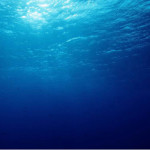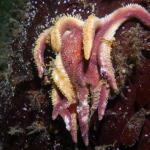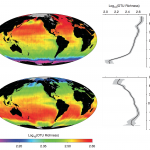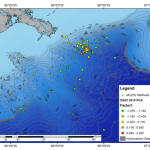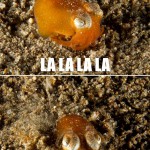I personally love doing this series because it allows me to explore and solidify a variety of ideas I mull over on daily basis. Previously in this series I have discussed the difficulty of sampling, the variety of habitats, linkages to the oceans surface, body size, conservation, undiscovered species, biodiversity, unexplored regions, the large spatial extent, and the very definition of the deep sea. For #11 in the series I will discuss who the movers and shakers are in deep-sea environments going all the way from fish to bacteria. We typically think of the deep-sea benthos (seafloor habitats and its organisms) as four overlapping but fairly distinctive groups. Most of the links on this page link to the wonderful compliations of Linda Kuhnz on Monterey Canyon organisms found over at MBARI’s website. Two different sites are there for megafauna and macrofauna/meiofauna.
• Megafauna–These are the big guys, the ones you would see if you could survive a walk across the deep-sea floor. More precisely, individuals are large enough to be seen in bottom photographs, video, or out a submersible window. A further division is used here between active (errant) and attached (sessile) organisms. The errant megafauna is dominated by echinoderms (brittle and basket stars, sea stars, urchins, and sea cucumbers). To lesser extent you also see decapod crustaceans (crabs, giant amphipods, and the such), fish, pycnogonid spiders, and cephalopods. For the sessile megafauna includes: sponges, including the spectaclular glass sponges; cnidarians including bottom dwelling jellyfish, corals, sea fans, sea pens, and anemones; and crinoids or sea lillies related to the seastars. These organisms range from active predators to scavengers to filter feeders (filtering particles out of the water) to deposit feeders (taking in sediment and stripping the bacteria and organic material out it).
• Macrofauna–These are small guys you wouldn’t see without a dissecting scope. The cutoff for macrofauna is anything retained on a 0.3 mm mesh sieve. These organisms can be either epifaunal or infaunal (on or in the sediment). Although there are representaives of most phyla here, three groups dominate. Polychaetes, the marine worms, make up typically 75% of any given sample. The crustaceans (various cumaceans, tanaids, amphipods, and isopods) with much less of the molluscs (bivalves, gastropods, and scaphopods or clams, snails, and tusk shells scaphopods) make up the remaining 25%. Like the megafauna the group is predators, scavengers, and deposit feeders. A few representatives are also filter feeders and parasites.
• Meiofauna–Really small animals. Individuals are retained on a sieve with a mesh size ≤ 62 μm. The ‘big’ players in this group are the nematodes, ostracods (the seed shrimp), harpacticoid copepods, and foraminifera (1, 2, & 3).
• Bacteria–the most important and most overlooked group. The basis of the food chain starts here.
Next 25 Things You Should Know will cover the ‘stability’ of deep-sea environments followed by notes on how temperatures slow processes in the deep sea.
Share the post "ARCHIVE: 25 Things You Should Know About the Deep Sea: #11 A Variety of Organisms Inhabit the Deep"

